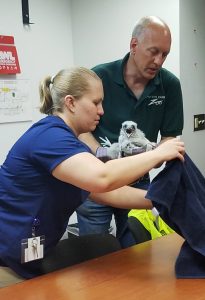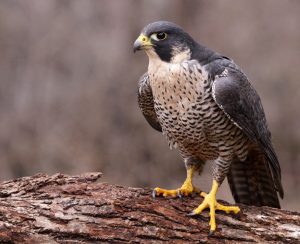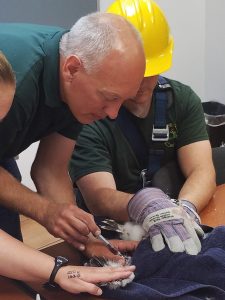By Rebecca Wood

Dr. Chris Tabaka holds Magic the peregrine falcon chick while his veterinary technician prepares to weigh her.
Potter Park Zoo once again helped lend a hand in banding a 1-month-old peregrine falcon chick. The Board of Water and Light (BWL) has been helping peregrine falcon chicks since 2004, and Potter Park Zoo has been involved in the process for many of those years. The endangered raptors have been nesting at the BWL’s Eckert Power Station for over 14 years. Being one of the highest places in the city, the power station is the urban equivalent to the cliffs the falcons would usually nest on in a more natural environment.
Peregrine falcons are a unique raptor species. The name peregrine comes from the Latin word peregrin which mean “traveler.” Fittingly, they cover incredibly long distances when migrating every year. A single migration can be up to 15,550 miles roundtrip. They are similar in size and weight to a large crow and can be distinguished from other raptors by their sharply hooked beak and a marking that looks similar to a mustache. When hunting for prey the usually medium sized birds swoop down with incredible speeds. Their normal flight speeds average between 25-35 mph, but when diving they can reach over 200 mph. Because of this they are often referred to as the fastest creature on the planet.

Peregrine falcons can be distinguished from other raptors by their mustache-like marking and sharply hooked beak.
Despite being one of the most widespread bird species, found on every continent except Antarctica, their status is still endangered in Michigan. The depletion of their population is primarily due to high mortality rates during the mid-1900s from DDT pesticide poisoning. DDT also caused any eggs laid to have an extremely fragile, thin shell which would break during the incubation period. This pesticide can take up to 15 years to break down in our environment. It is now banned in the United States and Europe, but there are still some countries using DDT. Despite the negative effects from this pesticide, the outlook is good for the species in Michigan. In 1964 a survey was conducted and found there were no breeding pairs of peregrine falcons east of the Mississippi River. However, after highly successful reintroductions into urban environments, the species was removed from the federal endangered species list in 1999. As previously mentioned, the raptors are still endangered in Michigan, but the Michigan Department of Natural Resources (DNR) is pleased with the number of mating pairs estimated to live in the state. They hope to soon delist the species in Michigan as well. One of the primary reasons for banding the chicks is to help monitor the population and track their movements to be sure the species is remaining stable.
Peregrines historically have an average of 2-3 chicks per year, but in recent years the Michigan DNR has noted an increase in the average number offspring. Last year the resident male, Tornado and his mate Ella successfully raised 3 chicks. Peregrine falcons usually mate for life, but Ella, unfortunately, disappeared earlier this year leaving Tornado with no mate. Since courtships usually begin in March, BWL staff were beginning to think there wouldn’t be any chicks this year.
Suddenly an unbanded female arrived at the nest in April. Despite being late in the season, Tornado accepted the female as his new mate. This most likely contributed to why only one chick hatched this year at the BWL.

Dr. Tabaka draws blood from the chick to analyze later.
Every year the Michigan DNR bands the nestlings before they are large enough to leave the nest. To minimize contact
with humans, as well as to cause as little stress as possible, Potter Park Zoo veterinarian staff performs a health assessment at the same time. A physical exam is performed to check for any malformations or injuries, blood is drawn to test for anything that might not physically manifest, and weight is recorded to assess if they are receiving enough food. Each chick is then given a vaccine for West Nile virus and powdered for lice. The chicks are then carefully passed over to a Wildlife Biologist with the DNR who bands each leg before returning the chick to a carrier for transport back to the nesting box.
By performing health assessments and banding the young raptors, Potter Park Zoo and the Michigan DNR are helping to monitor the species’ recovery. Peregrine falcons are one of the few species who are adapting well to urbanization. The abundance of prey, as well as the similarity of tall buildings to the cliffs peregrines are usually found in, makes it possible for the species to thrive. The future is looking bright for peregrine falcons in Michigan and Potter Park Zoo is grateful to be a part of the conservation of this species.



